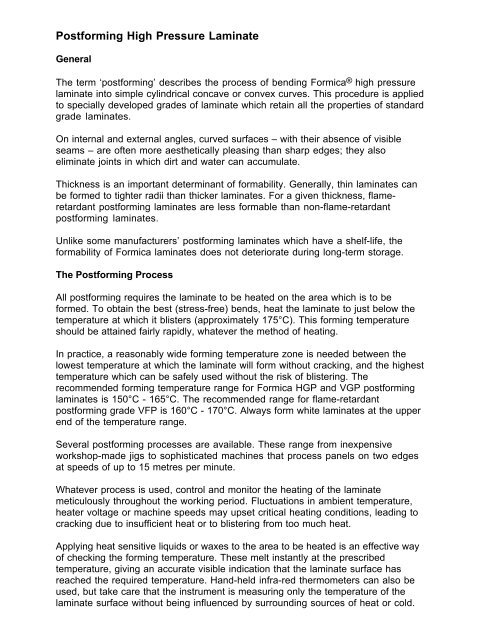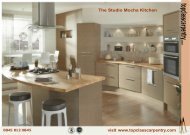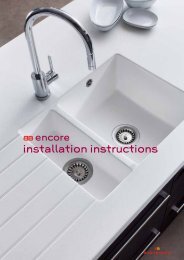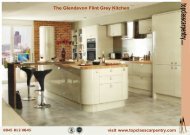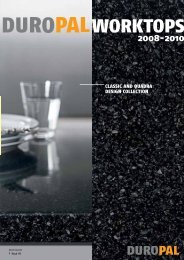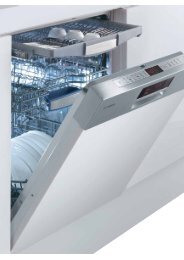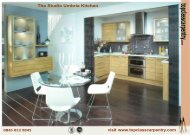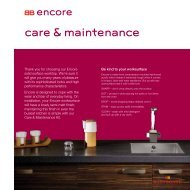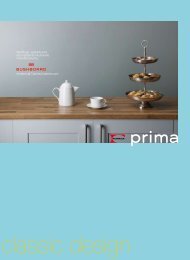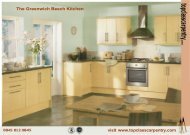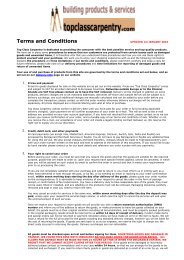Formica postforming laminate guide - Top Class Carpentry
Formica postforming laminate guide - Top Class Carpentry
Formica postforming laminate guide - Top Class Carpentry
Create successful ePaper yourself
Turn your PDF publications into a flip-book with our unique Google optimized e-Paper software.
Postforming High Pressure Laminate<br />
General<br />
The term ‘<strong>postforming</strong>’ describes the process of bending <strong>Formica</strong> ® high pressure<br />
<strong>laminate</strong> into simple cylindrical concave or convex curves. This procedure is applied<br />
to specially developed grades of <strong>laminate</strong> which retain all the properties of standard<br />
grade <strong>laminate</strong>s.<br />
On internal and external angles, curved surfaces – with their absence of visible<br />
seams – are often more aesthetically pleasing than sharp edges; they also<br />
eliminate joints in which dirt and water can accumulate.<br />
Thickness is an important determinant of formability. Generally, thin <strong>laminate</strong>s can<br />
be formed to tighter radii than thicker <strong>laminate</strong>s. For a given thickness, flameretardant<br />
<strong>postforming</strong> <strong>laminate</strong>s are less formable than non-flame-retardant<br />
<strong>postforming</strong> <strong>laminate</strong>s.<br />
Unlike some manufacturers’ <strong>postforming</strong> <strong>laminate</strong>s which have a shelf-life, the<br />
formability of <strong>Formica</strong> <strong>laminate</strong>s does not deteriorate during long-term storage.<br />
The Postforming Process<br />
All <strong>postforming</strong> requires the <strong>laminate</strong> to be heated on the area which is to be<br />
formed. To obtain the best (stress-free) bends, heat the <strong>laminate</strong> to just below the<br />
temperature at which it blisters (approximately 175°C). This forming temperature<br />
should be attained fairly rapidly, whatever the method of heating.<br />
In practice, a reasonably wide forming temperature zone is needed between the<br />
lowest temperature at which the <strong>laminate</strong> will form without cracking, and the highest<br />
temperature which can be safely used without the risk of blistering. The<br />
recommended forming temperature range for <strong>Formica</strong> HGP and VGP <strong>postforming</strong><br />
<strong>laminate</strong>s is 150°C - 165°C. The recommended range for flame-retardant<br />
<strong>postforming</strong> grade VFP is 160°C - 170°C. Always form white <strong>laminate</strong>s at the upper<br />
end of the temperature range.<br />
Several <strong>postforming</strong> processes are available. These range from inexpensive<br />
workshop-made jigs to sophisticated machines that process panels on two edges<br />
at speeds of up to 15 metres per minute.<br />
Whatever process is used, control and monitor the heating of the <strong>laminate</strong><br />
meticulously throughout the working period. Fluctuations in ambient temperature,<br />
heater voltage or machine speeds may upset critical heating conditions, leading to<br />
cracking due to insufficient heat or to blistering from too much heat.<br />
Applying heat sensitive liquids or waxes to the area to be heated is an effective way<br />
of checking the forming temperature. These melt instantly at the prescribed<br />
temperature, giving an accurate visible indication that the <strong>laminate</strong> surface has<br />
reached the required temperature. Hand-held infra-red thermometers can also be<br />
used, but take care that the instrument is measuring only the temperature of the<br />
<strong>laminate</strong> surface without being influenced by surrounding sources of heat or cold.
Equipment<br />
The usual method of <strong>postforming</strong> is first to glue the <strong>laminate</strong> to the flat area of the<br />
panel or worktop, which has been previously shaped on its edge to the required<br />
profile, then to form and bond the <strong>laminate</strong> simultaneously over the rounded edge.<br />
Glueing processes differ, but there are only two basic methods of <strong>postforming</strong> the<br />
<strong>laminate</strong>: stationary forming and continuous forming. In the first, the workpiece<br />
remains static during the forming operation; in the second, it is carried on a moving<br />
belt through the heating and forming zones of the machine.<br />
Stationary or Static Forming<br />
Static forming machines are simple bending rigs. The panel is pneumatically<br />
clamped to a flat stout bed with the overhanging <strong>laminate</strong> edge projecting. A<br />
retractable radiant heater descends and dwells over the <strong>laminate</strong> until the required<br />
forming temperature is reached. The heater is then retracted and an angled section<br />
folds the heated <strong>laminate</strong> over the edge profile and holds it in position until it is cool.<br />
An advantage of these machines is that they can be used for forming down-bends<br />
with large drop fronts.<br />
A different method of stationary <strong>postforming</strong> is used in the Brandt machines. The<br />
infra-red radiant heater is replaced by a narrow heated platen, which directly<br />
contacts the <strong>laminate</strong> surface and irons it around a prepared profile. Bonding and<br />
forming occur simultaneously. Being in reality a small mobile press, it can use<br />
almost any type of adhesive. These machines are fully automatic: once set to a<br />
particular profile they follow it repeatedly at the touch of a button.<br />
Continuous Forming<br />
Continuous forming machines vary in their size and output capacity, but all operate<br />
in a similar way. The panel, which has had the edges radiused and the <strong>laminate</strong><br />
bonded to the flat area, is carried by a chain or belt-drive through an infra-red<br />
heating zone, and past stainless steel bars which turn the now-softened <strong>laminate</strong><br />
over the profiled edge. Shaped rubber or metal rollers press the formed <strong>laminate</strong><br />
edge in place until the adhesive is cured, and the surplus <strong>laminate</strong> is trimmed off.<br />
Continuous machines fall into two groups using different adhesive systems.<br />
Continuous Process Using PVAc Adhesive<br />
These machines are favoured in the mass production kitchen furniture industry.<br />
They are automated; and they use adhesives which require no special extraction<br />
facilities and present no fire hazard.<br />
The panels or worktops are first veneered in a flat bonding press, with the <strong>laminate</strong><br />
overhanging the profiled edges. The <strong>postforming</strong> machines are self-contained<br />
units: they form, glue and trim in one pass.
© <strong>Formica</strong> Limited 2004<br />
Continuous Process Using Contact Adhesives<br />
These machines are usually double sided and capable of considerable width<br />
adjustment. The panel or worktop is first veneered by spraying both the <strong>laminate</strong><br />
and substrate (including the profiled edges) with neoprene adhesive, then bonding<br />
them under pressure by passing the assembly through rubber-covered nip rollers.<br />
For <strong>postforming</strong>, the <strong>laminate</strong> is first heated by passing through an infra-red heating<br />
zone to reach forming temperature. The heat reactivates the adhesive so that, when<br />
the <strong>laminate</strong> is formed and pressed home by the rollers, it instantly bonds with the<br />
adhesive coating on the profiled edges of the substrate.<br />
Coving<br />
The internal (concave) bend of a worktop with an integral riser is usually achieved by<br />
milling away the substrate in the area of the bend, then <strong>postforming</strong> the <strong>laminate</strong><br />
over a heated metal former. An MDF in-fill piece (heel-piece) is inserted and glued<br />
in position after the <strong>laminate</strong> has been formed.<br />
Substrates for Postformed Components<br />
The requirements for a good substrate in general fabrication apply also in<br />
<strong>postforming</strong>. In addition, a substrate with good edge machining properties<br />
(producing a smooth clean finish with minimum break-out) is required to provide<br />
both a smooth transition from the flat into the radius, and flawless adhesion over<br />
the curve with minimum show-through.<br />
1. Chipboard<br />
Good quality chipboard with a smooth and even surface finish is essential. It should<br />
be constructed to prevent tearing out of the chip particles during the edge profiling<br />
process and should provide a fine even surface with no voids. Brush to remove<br />
loose particles after machining the profile.<br />
2. MDF<br />
The excellent machining qualities of MDF make it an ideal substrate for smooth<br />
edge profiles.<br />
3. Plywood<br />
Machining of the profile is more difficult with plywood as the multiple glue-lines can<br />
produce unequal wear of cutter blades. Keep blades as sharp as possible; clean<br />
them regularly and coat with a release agent to prevent resin build-up.<br />
A post-sanding operation followed by brushing is advisable after machining. The<br />
machining direction should follow the grain of the surface veneers.<br />
4. Solid Nose-pieces<br />
Where components require a large external radius, fashion the profile from built-up<br />
sections of MDF or chipboard and never from solid timber, which may shrink and<br />
produce ripples on the <strong>laminate</strong> surface.


